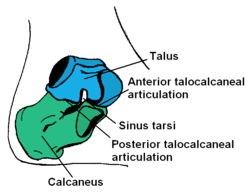Astragalus bone
| Talus bone | |
|---|---|

Anatomy of the right foot
|
|

Subtalar Joint, viewed from an angle between lateral and frontal.
|
|
| Details | |
| Identifiers | |
| Latin | Os trigonum, Astragalus |
| MeSH | A02.835.232.043.300.710.780 |
| TA | A02.5.10.001 |
| FMA | 9708 |
|
Anatomical terms of bone
[]
|
|
The talus bone (/ˈteɪləs/; Latin for ankle), astragalus /əˈstræɡələs/, or ankle bone is one of the group of foot bones known as the tarsus. The tarsus forms the lower part of the ankle joint through its articulations with the lateral and medial malleoli of the two bones of the lower leg, the tibia and fibula. Within the tarsus, it articulates with the calcaneus below and navicular in front within the talocalcaneonavicular joint. Through these articulations, it transmits the entire weight of the body to the foot.
The second largest of the tarsal bones, it is also one of the bones in the human body with the highest percentage of its surface area covered by articular cartilage. Additionally, it is also unusual in that it has a retrograde blood supply, i.e. arterial blood enters the bone at the distal end.
...
Wikipedia
